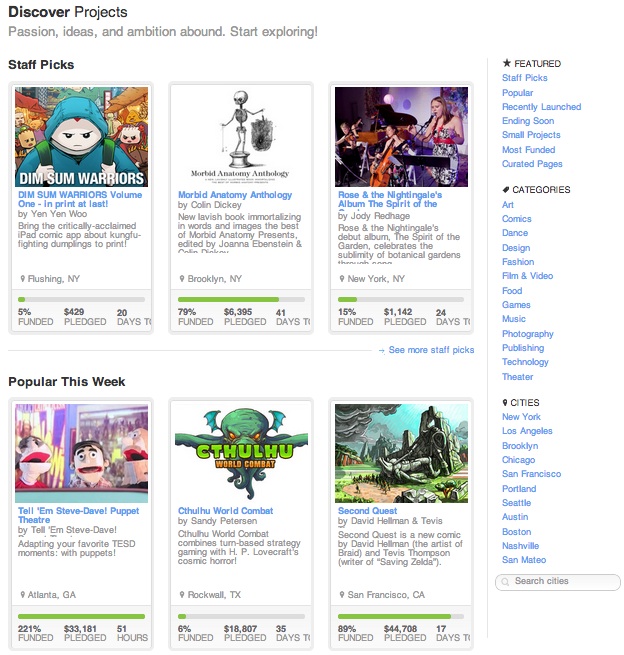Collaboration @ Kickstarter
I’m fascinated by Kickstarter. It’s entertainment, collaboration, and belonging all rolled up into a compelling social experience with real-world impact. If I see that someone I admire has backed a project, I can’t resist learning more – I click on the link, watch the project video, and sometimes decide to back that project myself. When I do, I feel closer to the other backers – and to the creator. For the duration of that project, we’re a mini-community, united in our support of the vision and goals of the creators.
 So how does Kickstarter enable this sense of connection and collaboration? To gain insight, let’s take a look at the core Social Actions in Kickstarter (click here to learn more about this analytic technique)
So how does Kickstarter enable this sense of connection and collaboration? To gain insight, let’s take a look at the core Social Actions in Kickstarter (click here to learn more about this analytic technique)
The entertainment value of Kickstarter is a big part of it’s ongoing allure. There is always a fresh stream of offbeat, surprising, creative projects to EXPLORE – and the creativity and passion expressed in Kickstarter videos makes them fun to watch. Plus, you get the added “what-will-happen?” fun of seeing how the projects evolve over time as they succeed – or fail – to get funding.
Kickstarter doubles-down on people’s love of exploring by providing many different ways to explore. You can search for your favorite pastimes or artists, or click on different lists to browse through featured projects. However you like to explore, Kickstarter makes it easy to keep clicking on cool stuff.
 On Kickstarter, your identity emerges as you back projects – and if you’re a creator, as you run campaigns. Kickstarter players EXPRESS themselves by supporting projects they care about and want to see happen. Your profile showcases the projects and categories you’ve backed (but not how much you contributed). You see chronological project listings, plus a piechart icon showing which categories you’ve invested in. The visual icon style – blank areas, filled in as you take actions – suggests a progress meter or collection device, not necessarily in a bad way.
On Kickstarter, your identity emerges as you back projects – and if you’re a creator, as you run campaigns. Kickstarter players EXPRESS themselves by supporting projects they care about and want to see happen. Your profile showcases the projects and categories you’ve backed (but not how much you contributed). You see chronological project listings, plus a piechart icon showing which categories you’ve invested in. The visual icon style – blank areas, filled in as you take actions – suggests a progress meter or collection device, not necessarily in a bad way.
 Kickstarter campaigns have a game-like structure with time constraints, visible progress metrics, and a win/lose state. When you launch a campaign, you set your fundraising goal and the number of days you have to achieve that goal. If you meet your fundraising goal, you get the funds pledged – and if you don’t, the funds are returned. Thus, players COMPETE with the system to get their project funded, which adds urgency and excitement to the overall experience, and drives social network outreach for everyone involved.
Kickstarter campaigns have a game-like structure with time constraints, visible progress metrics, and a win/lose state. When you launch a campaign, you set your fundraising goal and the number of days you have to achieve that goal. If you meet your fundraising goal, you get the funds pledged – and if you don’t, the funds are returned. Thus, players COMPETE with the system to get their project funded, which adds urgency and excitement to the overall experience, and drives social network outreach for everyone involved.
Within this same structure, players COLLABORATE with each other – and the creator – by pledging funds and doing social outreach. It’s this productive coupling of collaborating with people while competing against the system that leads to successful, purpose-driven collective action.